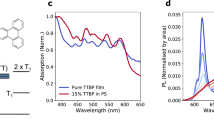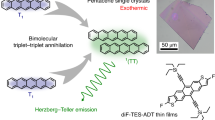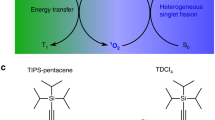Abstract
Singlet fission promises to surpass the Shockley–Queisser limit for single-junction solar cell efficiency through the production of two electron–hole pairs per incident photon. However, this promise has not been fulfilled because singlet fission produces two low-energy triplet excitons that have been unexpectedly difficult to dissociate into free charges. To understand this phenomenon, we study charge separation from triplet excitons in polycrystalline pentacene using an electrochemical series of 12 different guest electron-acceptor molecules with varied reduction potentials. We observe separate optima in the charge yield as a function of driving force for singlet and triplet excitons, including inverted regimes for the dissociation of both states. Molecular acceptors can thus provide a strategic advantage to singlet fission solar cells by suppressing singlet dissociation at optimal driving forces for triplet dissociation. However, even at the optimal driving force, the rate constant for charge transfer from the triplet state is surprisingly small, ~107 s−1, presenting a previously unidentified obstacle to the design of efficient singlet fission solar cells.
This is a preview of subscription content, access via your institution
Access options
Access Nature and 54 other Nature Portfolio journals
Get Nature+, our best-value online-access subscription
$29.99 / 30 days
cancel any time
Subscribe to this journal
Receive 12 print issues and online access
$259.00 per year
only $21.58 per issue
Buy this article
- Purchase on Springer Link
- Instant access to full article PDF
Prices may be subject to local taxes which are calculated during checkout





Similar content being viewed by others
Data availability
The datasets generated and analysed during the current study are available from the corresponding author on reasonable request.
Code availability
The code generated during the current study is available from the corresponding author on reasonable request.
References
Hanna, M. C. & Nozik, A. J. Solar conversion efficiency of photovoltaic and photoelectrolysis cells with carrier multiplication absorbers. J. Appl. Phys. 100, 074510 (2006).
Beard, M. C., Johnson, J. C., Luther, J. M. & Nozik, A. J. Multiple exciton generation in quantum dots versus singlet fission in molecular chromophores for solar photon conversion. Phil. Trans. R. Soc. A 373, 20140412 (2015).
Smith, M. B. & Michl, J. Recent advances in singlet fission. Annu. Rev. Phys. Chem. 64, 361–386 (2013).
Lee, J., Jadhav, P. & Baldo, M. A. High efficiency organic multilayer photodetectors based on singlet exciton fission. Appl. Phys. Lett. 95, 033301 (2009).
Congreve, D. N. et al. External quantum efficiency above 100% in a singlet-exciton-fission-based organic photovoltaic cell. Science 340, 334–337 (2013).
Xu, X. et al. 8.0% efficient all-polymer solar cells with high photovoltage of 1.1 V and internal quantum efficiency near unity. Adv. Energy Mater. 8, 1700908 (2017).
Gélinas, S. et al. Ultrafast long-range charge separation in organic semiconductor photovoltaic diodes. Science 343, 512–516 (2014).
Provencher, F. et al. Direct observation of ultrafast long-range charge separation at polymer–fullerene heterojunctions. Nat. Commun. 5, 4288 (2014).
Marcus, R. A. On the theory of oxidation–reduction reactions involving electron transfer. I. J. Chem. Phys. 24, 966–978 (1956).
Adams, D. M. et al. Charge transfer on the nanoscale: current status. J. Phys. Chem. B 107, 6668–6697 (2003).
Hush, N. S. et al. Distance dependence of photoinduced electron-transfer through non-conjugated bridges. Chem. Phys. Lett. 117, 8–11 (1985).
Miller, J. R., Calcaterra, L. T. & Closs, G. L. Intramolecular long-distance electron transfer in radical anions. The effects of free energy and solvent on the reaction rates. J. Am. Chem. Soc. 106, 3047–3049 (1984).
Wasielewski, M. R. Photoinduced electron transfer in supramolecular systems for artificial photosynthesis. Chem. Rev. 92, 435–461 (1992).
Gust, D., Moore, T. A. & Moore, A. L. Molecular mimicry of photosynthetic energy and electron transfer. Acc. Chem. Res. 26, 198–205 (2002).
Coffey, D. C. et al. An optimal driving force for converting excitons into free carriers in excitonic solar cells. J. Phys. Chem. C 116, 8916–8923 (2012).
Ihly, R. et al. Tuning the driving force for exciton dissociation in single-walled carbon nanotube heterojunctions. Nat. Chem. 8, 603–609 (2016).
Lenhard, J. R. & Hein, B. R. Effects of J-aggregation on the redox levels of a cyanine dye. J. Phys. Chem. 100, 17287–17296 (1996).
Pace, N. A., Reid, O. G. & Rumbles, G. Delocalization drives free charge generation in conjugated polymer films. ACS Energy Lett. 3, 735–741 (2018).
Chaudhuri, S. et al. Electron transfer assisted by vibronic coupling from multiple modes. J. Chem. Theory Comput. 13, 6000–6009 (2017).
Tabachnyk, M. et al. Efficient singlet exciton fission in pentacene prepared from a soluble precursor. APL Mater. 4, 116112 (2016).
Ramanan, C., Smeigh, A. L., Anthony, J. E., Marks, T. J. & Wasielewski, M. R. Competition between singlet fission and charge separation in solution-processed blend films of 6,13-bis(triisopropylsilylethynyl)pentacene with sterically-encumbered perylene-3,4:9,10-bis(dicarboximide)s. J. Am. Chem. Soc. 134, 386–397 (2011).
Gong, H.-X., Cao, Z., Li, M.-H., Liao, S.-H. & Lin, M.-J. Photoexcited perylene diimide radical anions for the reduction of aryl halides: a bay-substituent effect. Org. Chem. Front. 5, 2296–2302 (2018).
Günbaş, D. D. et al. High charge carrier mobility and efficient charge separation in highly soluble perylenetetracarboxyl-diimides. Chem. Commun. 50, 4955–4958 (2014).
Struijk, C. W. et al. Liquid crystalline perylene diimides: architecture and charge carrier mobilities. J. Am. Chem. Soc. 122, 11057–11066 (2000).
Saeki, A., Seki, S. & Tagawa, S. Electrodeless measurement of charge carrier mobility in pentacene by microwave and optical spectroscopy techniques. J. Appl. Phys. 100, 023703 (2006).
Honsho, Y., Miyakai, T., Sakurai, T., Saeki, A. & Seki, S. Evaluation of intrinsic charge carrier transport at insulator–semiconductor interfaces probed by a non-contact microwave-based technique. Sci. Rep. 3, 1371 (2013).
Ern, V. & Merrifield, R. E. Magnetic field effect on triplet exciton quenching in organic crystals. Phys. Rev. Lett. 21, 609–611 (1968).
Cox, M., Janssen, P., Zhu, F. & Koopmans, B. Traps and trions as origin of magnetoresistance in organic semiconductors. Phys. Rev. B 88, 035202 (2013).
Gesquiere, A. J., Park, S.-J. & Barbara, P. F. Hole-induced quenching of triplet and singlet excitons in conjugated polymers. J. Am. Chem. Soc. 127, 9556–9560 (2005).
Zarrabi, N., Burn, P. L., Meredith, P. & Shaw, P. E. Acceptor and excitation density dependence of the ultrafast polaron absorption signal in donor–acceptor organic solar cell blends. J. Phys. Chem. Lett. 7, 2640–2646 (2016).
Larson, B. W. et al. Electron affinity of phenyl–C61–butyric acid methyl ester (PCBM). J. Phys. Chem. C 117, 14958–14964 (2013).
Murata, Y., Kato, N., Fujiwara, K. & Komatsu, K. Solid-state [4 + 2] cycloaddition of fullerene C60 with condensed aromatics using a high-speed vibration milling technique. J. Org. Chem. 64, 3483–3488 (1999).
Proudian, A. P. et al. Effect of Diels–Alder reaction in C60-tetracene photovoltaic devices. Nano Lett. 16, 6086–6091 (2016).
Jamieson, F. C. et al. Fullerene crystallisation as a key driver of charge separation in polymer/fullerene bulk heterojunction solar cells. Chem. Sci. 3, 485–492 (2012).
Larson, B. W. et al. Inter-fullerene electronic coupling controls the efficiency of photoinduced charge generation in organic bulk heterojunctions. Adv. Energy Mater. 6, 1601427 (2016).
Yong, C. K. et al. The entangled triplet pair state in acene and heteroacene materials. Nat. Commun. 8, 1–12 (2018).
Trinh, M. T. et al. Distinct properties of the triplet pair state from singlet fission. Sci. Adv. 3, e1700241 (2017).
Schrauben, J. N. et al. Photocurrent enhanced by singlet fission in a dye-sensitized solar cell. ACS Appl. Mater. Interfaces 7, 2286–2293 (2015).
Pace, N. A. et al. Dynamics of singlet fission and electron injection in self-assembled acene monolayers on titanium dioxide. Chem. Sci. 9, 3004–3013 (2018).
Lee, J. et al. Singlet exciton fission photovoltaics. Acc. Chem. Res. 46, 1300–1311 (2013).
Odom, S. A., Parkin, S. R. & Anthony, J. E. Tetracene derivatives as potential red emitters for organic LEDs. Org. Lett. 5, 4245–4248 (2003).
Kroupa, D. M. et al. Control of energy flow dynamics between tetracene ligands and PbS quantum dots by size tuning and ligand coverage. Nano Lett. 18, 865–873 (2018).
Holliday, S. et al. A rhodanine flanked nonfullerene acceptor for solution-processed organic photovoltaics. J. Am. Chem. Soc. 137, 898–904 (2015).
Clikeman, T. T. et al. Core perylene diimide designs via direct bay- and ortho-(poly)trifluoromethylation: synthesis, isolation, X-ray structures, optical and electronic properties. Eur. J. Org. Chem. 2015, 6641–6654 (2015).
Gao, J., Xiao, C., Jiang, W. & Wang, Z. Cyano-substituted perylene diimides with linearly correlated LUMO levels. Org. Lett. 16, 394–397 (2013).
Reid, O. G. et al. Quantitative analysis of time-resolved microwave conductivity data. J. Phys. D 50, 493002 (2018).
Savenije, T. J., Ferguson, A. J., Kopidakis, N. & Rumbles, G. Revealing the dynamics of charge carriers in polymer:fullerene blends using photoinduced time-resolved microwave conductivity. J. Phys. Chem. C 117, 24085–24103 (2013).
Acknowledgements
This work was produced in part by the National Renewable Energy Laboratory, operated by Alliance for Sustainable Energy, for the US Department of Energy under Contract No. DE-AC36–08GO28308. Funding provided by the Solar Photochemistry Program of the US Department of Energy, Office of Basic Energy Sciences, Division of Chemical Sciences, Biosciences and Geosciences. The views expressed in the article do not necessarily represent the views of the US Department of Energy or the US Government. T.T.C., S.H.S. and O.V.B. thank the National Science Foundation (grants CHE-1012468 and CHE-1362302) for support of the synthesis of PDI acceptors. S.H. and I.M. thank BASF, EPSRC (EP/G037515/1), EPSRC (EP/L016702/1), EC FP7 Project X10D (287818) and Nanomatcell (308997) for support of the synthesis of rhodanine acceptors. D.B.G. and J.E.A. thank the National Science Foundation (DMREF-1627428) for support of the synthesis of tetracene acceptors. We thank P. Parilla for advice regarding X-ray diffraction crystallite size measurements. We thank E. Pace for creating the table of contents graphic.
Author information
Authors and Affiliations
Contributions
N.A.P. fabricated samples; performed steady-state absorption, X-ray diffraction, TA and TRMC measurements; synthesized PDI(dodecyl)-(CN)3 and PDI(dodecyl)-(CN)4 samples; and contributed to experimental design. N.V.K. synthesized PDI(dodecyl)-(CN)3 and PDI(dodecyl)-(CN)4 samples. T.T.C., S.H.S. and O.V.B. synthesized PDI(Bu)-(CF3)2, PDI(Bu)-(CF3)3, PDI(F7Bu)-(CF3)3 and PDI(F7Bu)-(CF3)4 samples. S.H. and I.M. synthesized FTR, FBR and CN-FBR samples. D.B.G. and J.E.A. synthesized TIPS Tc and TIPS Tc COOH samples. G.M.C. performed cyclic voltammetry measurements. S.U.N. performed atomic force microscopy measurements. J.C.J., G.R. and O.G.R. contributed to overall experimental design and supervised the project.
Corresponding authors
Ethics declarations
Competing interests
The authors declare no competing interests.
Additional information
Publisher’s note Springer Nature remains neutral with regard to jurisdictional claims in published maps and institutional affiliations.
Supplementary information
Supplementary information
Supplementary data, including further details and analysis of the kinetic Monte Carlo model, TRMC, TA, X-ray diffraction, steady-state absorption and electrochemical measurements; synthetic methods; Figs. 1–23 and Tables 1–3.
Rights and permissions
About this article
Cite this article
Pace, N.A., Korovina, N.V., Clikeman, T.T. et al. Slow charge transfer from pentacene triplet states at the Marcus optimum. Nat. Chem. 12, 63–70 (2020). https://doi.org/10.1038/s41557-019-0367-x
Received:
Accepted:
Published:
Issue Date:
DOI: https://doi.org/10.1038/s41557-019-0367-x



